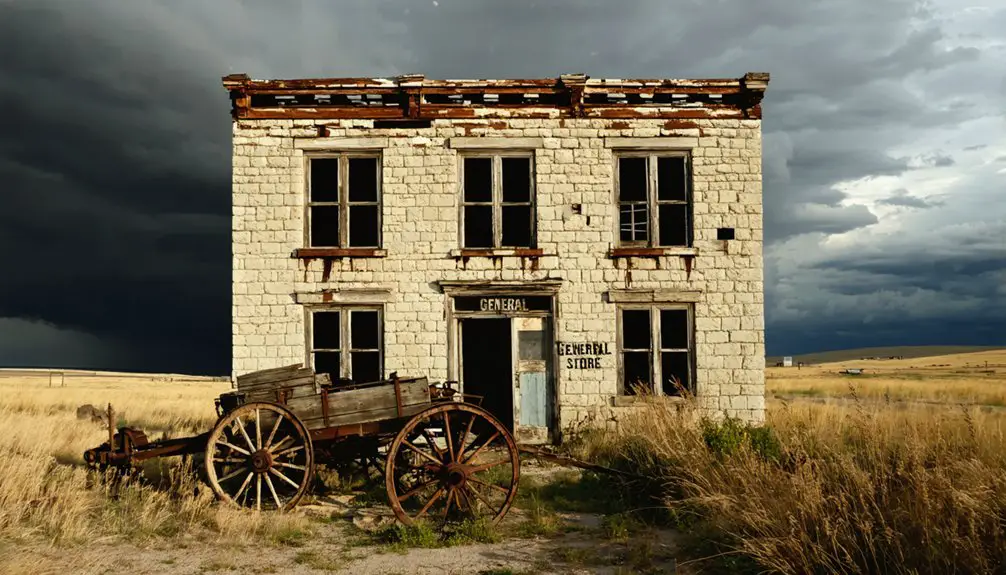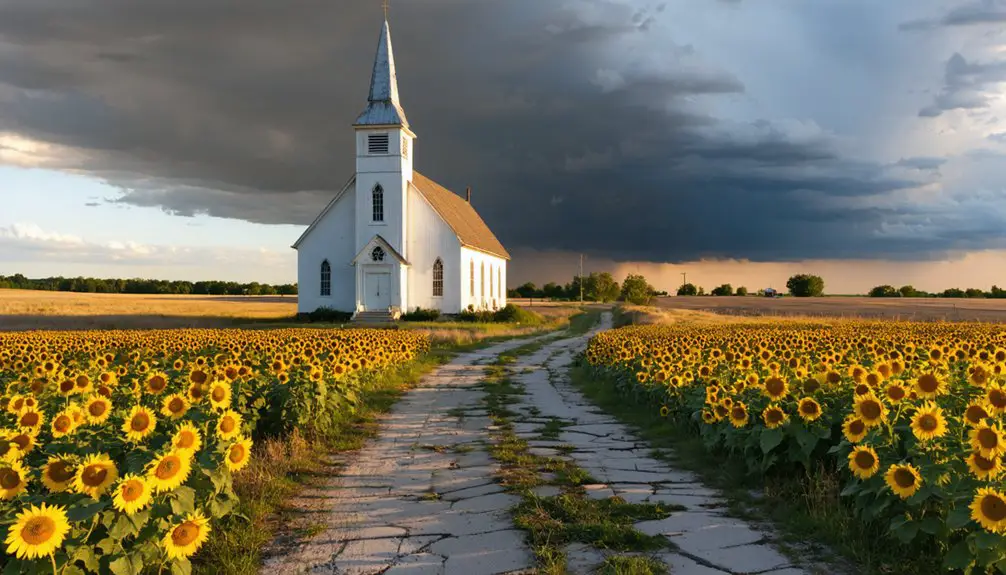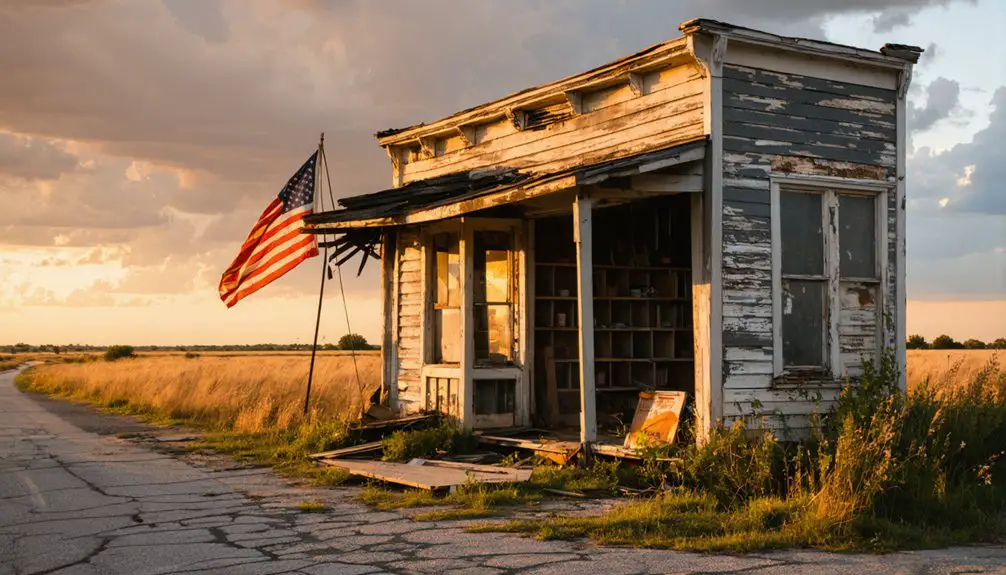You’ll find Collyer, Kansas as a semi-ghost town today with just over 100 residents, though it began as a thriving Civil War veterans’ colony in 1878. Under Rev. Robert Collyer’s leadership, the settlement grew to 3,500 settlers by 1879, drawing Irish Catholics and other immigrant groups. Despite the Union Pacific Railroad’s presence, harsh weather, crop failures, and the Dust Bowl gradually reduced the population. The town’s abandoned buildings and cultural heritage tell a deeper story of pioneer resilience.
Key Takeaways
- Collyer began as a Civil War veterans’ colony in 1878, reaching peak population in mid-1879 with 3,500 settlers before gradual decline.
- Environmental challenges including brutal winters, droughts, and the Dust Bowl contributed significantly to Collyer’s transformation into a semi-ghost town.
- Population decline accelerated between 1940s-1960s, with residents relocating and often moving entire houses to nearby farming properties.
- The town retains over 100 residents today, qualifying it as a semi-ghost town rather than completely abandoned.
- Originally named after Rev. Robert Collyer, the settlement’s location shifted multiple times to stay near railroad access and water sources.
The Birth of a Civil War Soldiers’ Colony
In January 1878, a group of Civil War veterans established a unique settlement near the Union Pacific Railroad in western Kansas’s Trego County.
These pioneers, mainly from Illinois and Chicago, created their first communal shelter called the “Colony House” – a one-and-a-half story structure that served as temporary housing for about 80 families during the initial settler experiences.
You’ll find that settler experiences were shaped by diverse ethnic backgrounds, with Irish families arriving in the 1870s and 1880s, followed by Bohemians and Germans from Odessa. The veterans’ monthly pension payments provided crucial financial stability during their transition to farming life.
The community dynamics centered around shared resources, including a wagon, team of horses, and a lending library for each colonist.
The settlers embraced communal living, sharing essential resources from horse-drawn wagons to books through a pioneering library system.
The settlement, which would later be named Collyer, relocated twice to secure better water access, demonstrating the pioneers’ determination to build a sustainable future.
The settlers developed crucial infrastructure early on, including the first windmill in 1884 built by Mr. Blackwell for grinding feed.
Rev. Robert Collyer’s Vision and Support
While serving as president of the Civil War veterans’ colony, Reverend Robert Collyer played a pivotal role in shaping the settlement’s early development through his extensive support system.
Collyer’s leadership extended beyond administration – he actively financed land claim filing fees, shipped construction materials, and provided transportation resources to help settlers establish their new homes. Drawing from his experience with the Sanitary Commission, he implemented effective systems for distributing aid and resources to the settlers. Like the early Methodists who created Shelby Seminary, he understood the importance of establishing strong community institutions.
You’ll find his influence throughout the early colony’s framework. He sent books to create a lending library, coordinated with Colonel Pratt to secure backing, and oversaw the construction of Colony House, which became the settlement’s central gathering place.
During difficult times, including Indian scares and crop failures, Collyer’s settler support proved invaluable. His dedication to the community was so significant that settlers named their town “Collyer” in his honor.
Railroad Impact and Town Relocations
You’ll find that the Union Pacific Railroad’s arrival in 1867 sparked the initial settlement patterns in Trego County, establishing water stations at locations like Park’s Fort, Trego Tank, and Coyote.
Railroad workers endured harsh conditions, living in primitive dugouts during the winter of 1867-1868.
The railroad’s westward push toward Denver forced several towns to relocate, including the movement of buildings and residents from Coyote to what would become Collyer.
The availability of water sources for steam engines ultimately determined Collyer’s permanent location in Section 5, Township 12, Range 25, where both the section house and store from Coyote were relocated.
Much like the Scott Special train that achieved record speeds in 1905, these early rail lines were crucial to connecting Western towns to major cities.
Railroad Brings Initial Settlement
As the Union Pacific Railroad pushed through Trego County in 1867, it established essential water stations at Park’s Fort, Trego Tank, and Coyote near present-day Collyer to service steam engines.
These railroad logistics played a vital role in shaping early settlement patterns, with Coyote hosting a section house and mobile store that would later move to Collyer.
While the railroad initially paused after winter 1867-1868, its extension to Denver by 1870 drew waves of hopeful settlers westward. The region’s altitude of 3000 feet above sea level presented unique challenges for early farming attempts.
You’ll find that the most significant influx came in 1878-1879 when Rev. Robert Collyer organized a colony of soldiers, sailors, and citizens from Illinois and Chicago.
The promise of rail access attracted approximately 3,500 settlers by mid-1879, including diverse European immigrants seeking new opportunities in the Kansas frontier. The poor crop yields in that same year caused many settlers to abandon their homesteads and pursue cattle and sheep farming instead.
Station Forced Town Movement
Because railroad stations dictated economic prosperity in frontier Kansas, Collyer’s original settlement at Coyote faced a crucial decision when the Union Pacific established its permanent station location in 1879.
The station placement, about a mile from Coyote, forced the town’s residents to confront economic necessity. You’d have seen buildings dismantled piece by piece, loaded onto wagons, and hauled to the new location near the tracks. Much like how fugitive slaves sought freedom after the Dred Scott decision, towns had to adapt to survive changing circumstances.
This wasn’t just about moving structures – it was about survival. Towns without direct rail access often withered into obscurity, losing businesses and population to better-connected locations. Like the early French fur trappers who established trade routes, the railroad became vital for commerce and settlement.
Moving closer to the station meant immediate access to broader markets, reliable transportation, and new commercial opportunities. The relocated town could now attract more settlers, merchants, and trade, ensuring its place in Kansas’s growing rail network.
Water Source Drives Relocation
While the railroad station’s location initially drove Collyer’s move from Coyote, the critical need for water sparked additional relocations in the town’s early years.
Water management challenges shaped settlement patterns as the community searched for reliable sources to serve both residents and steam engines on the Union Pacific line.
- The town’s first well near Wheeler store relied on a manual pulley system with buckets
- Discovery of better water supplies prompted a move half a mile east
- A subsequent relocation led by Keeney pushed the town three-quarters of a mile further east
- Railroad operations required strategic water access points every few miles
You’ll find that these water-driven moves reflect a common theme in 19th-century frontier development, where towns often shifted locations based on natural resource availability.
Early Settlers and Their Struggles

The first Irish settlers of Collyer arrived in March 1878 as part of the Chicago Colony, with families like the Walshes, Gubbins, and Spicers establishing the initial community around the Colony House at Coyote station.
You’ll find these pioneering families quickly faced nature’s wrath as hot winds and drought conditions devastated their early crop attempts, forcing many to abandon their claims.
Those who stayed proved their farmland claims despite the harsh climate, often relocating their houses and repurposing abandoned buildings to sustain their agricultural pursuits.
First Chicago Colony Arrives
In January 1878, a pioneering group formed the Chicago Colony under the leadership of Colonel Pratt and Rev. Robert Collyer, D.D. They’d collect a five-dollar membership fee to fund their dream of settling in Trego County, Kansas.
Despite settlement challenges, they established their first base at Coyote, near the Kansas Pacific Railway.
You’ll find these key developments marked their arrival:
- A locating committee of five men scouted and claimed suitable land
- Col. Pratt built a 30′ x 16′ Colony House in March 1878 for temporary shelter
- R.G. Kessler became the first postmaster in May 1878
- The Colony House sheltered about 80 families during early settlement
The community’s resilience showed as they faced displacement from railroad right-of-way, leading them to relocate near a water supply where the Wheeler Brothers built the first store.
Weather Tests Pioneer Spirit
Life on Kansas’s frontier tested settlers’ resolve as brutal weather patterns dominated their daily existence from the 1850s onward. You’d find winters plunging below -20°F with two-foot snowfalls, while summers brought relentless dust storms from wind-swept prairie grass and tilled soil.
The 1881 blizzard left pioneers isolated for 11 days, forcing them to coordinate oxen-led rescue missions.
Pioneer resilience emerged through environmental adaptation as settlers burned furniture to survive the cold and built sod homes for protection.
You’d witness their struggle against the devastating 16-month drought of 1859, which left the ground dry as ashes. Grasshopper swarms and frequent crop failures complicated survival further.
Despite these hardships, settlers developed innovative solutions, from improved water wells to wind-resistant structures, demonstrating their determination to tame the harsh Kansas frontier.
Farmland Claims and Survival
As pioneers began staking their claims in Collyer during 1876, B.O. Richards led the way near Coyote. By 1878, you’d find the Chicago Colony filing land claims for just $2.00 per piece. Your survival strategies would’ve centered around Col. Pratt’s Colony House, which sheltered 80 families while they built permanent homes.
To understand the settlers’ determination, consider these essential aspects:
- Water access drove settlement locations, forcing two town relocations.
- Religious networks, especially Irish Catholic families, supported newcomers.
- Shared resources like wagons and horses helped manage limited supplies.
- Proving up your land meant showing legitimate cultivation and residence.
You’d face brutal challenges – hot winds, droughts, and crop failures tested even the most resilient pioneers, yet many stayed to fight for their piece of Kansas soil.
Ethnic Migration Waves and Community Growth

While Collyer’s initial colonization began around 1878 with settlers from Illinois, the town’s ethnic composition would dramatically evolve through successive waves of immigration.
You’ll find that Irish Catholic families like the Walshes and O’Tooles arrived first, followed by a significant influx of Bohemian settlers in 1889, including the Kristof and Rozak families.
This ethnic diversity expanded further between 1900 and 1915 when Volga Germans from Russia joined the community.
The Kansas Pacific Railroad played a vital role in these migration patterns, though it also forced settlers to relocate their homes multiple times.
Despite these challenges, the various ethnic groups worked together to establish community institutions, particularly St. Michael Parish, which became the cornerstone of their shared religious and cultural life.
Natural Resources and Agricultural Challenges
The harsh natural environment of Collyer presented constant challenges to its diverse immigrant population.
Natural resource management proved difficult with limited water access, forcing early settlers to relocate the town multiple times within short distances. You’ll find that agricultural sustainability was severely tested by the region’s semi-arid climate and marginal soil quality.
- Unreliable rainfall patterns and frequent droughts led to devastating crop failures
- Limited groundwater sources restricted irrigation possibilities
- Poor soil fertility confined farming to drought-resistant crops
- The Dust Bowl era highlighted the area’s vulnerability to extreme weather
The combination of these challenges created a precarious existence for farmers, who’d to adapt their techniques continually.
Without significant mineral resources or fertile soil to support economic diversification, the community remained vulnerable to agricultural setbacks.
The Decline and Historical Legacy

Despite its hopeful beginnings, Collyer experienced a dramatic population decline starting in the early 1900s, with the sharpest drops occurring between the 1940s and 1960s.
You’ll find evidence of this decline in the empty houses that were often moved to nearby farms as residents relocated due to crop failures and economic hardship.
The town’s cultural heritage remains rich, shaped by diverse immigrant groups including Germans, Bukovina Germans, Volga Germans, and Irish settlers.
While the population resilience was tested by the Dust Bowl and Great Depression, some families stayed to maintain their farming legacy.
Though officially incorporated in 1917, Collyer has transformed into a semi-ghost town.
Today, you’ll discover over 100 residents still calling it home, living among abandoned buildings that tell the story of its challenging past.
Frequently Asked Questions
What Happened to the Original Colony House Building After Its Forced Removal?
Pioneers purposefully pulled apart your historic house when building relocation proved too difficult. You’ll find the Wheeler Brothers dismantled it completely, likely letting locals salvage and reuse the materials elsewhere.
Are There Any Remaining Structures or Ruins Visible in Collyer Today?
You’ll find limited remaining structures consisting mainly of scattered old farmhouses. There aren’t prominent visible ruins or commercial buildings, making it challenging to spot much evidence of the former settlement.
What Was the Average Land Price for Settlers in Collyer?
While you’d hope for clear records of land value and settlement costs, there’s no documented average price for early Collyer settlers. You’re left with only hints from nearby Trego County transactions.
Did Any Notable Crimes or Lawlessness Occur During Collyer’s Peak Years?
You won’t find documented evidence of major crime history or lawlessness during the peak years. With minimal law enforcement presence, the agricultural community remained particularly stable through cooperative social structures and shared survival goals.
What Traditional Celebrations or Festivals Were Held in Early Collyer?
Like seeds scattered across prairie soil, you’d find settlers gathering at Colony House for traditional dances, while harvest festivals brought the community together through shared meals and celebrations.
References
- https://www.ksgenweb.org/KSTrego/collyer.html
- https://fhsuguides.fhsu.edu/kansasheritage/tregocounty
- https://legendsofkansas.com/trego-county-kansas/
- https://www.ksgenweb.org/KSTrego/ghost.html
- https://en.wikipedia.org/wiki/Bosna
- https://www.historynet.com/a-place-of-their-own/
- https://www.wyohistory.org/encyclopedia/11th-kansas-cavalry-kansas-and-west
- https://khri.kansasgis.org/photos_docs/195-1080-00005_9.pdf
- https://en.wikipedia.org/wiki/Robert_Collyer_(clergyman)
- https://edenmartin.com/newsite/counties/chpt14.htm



